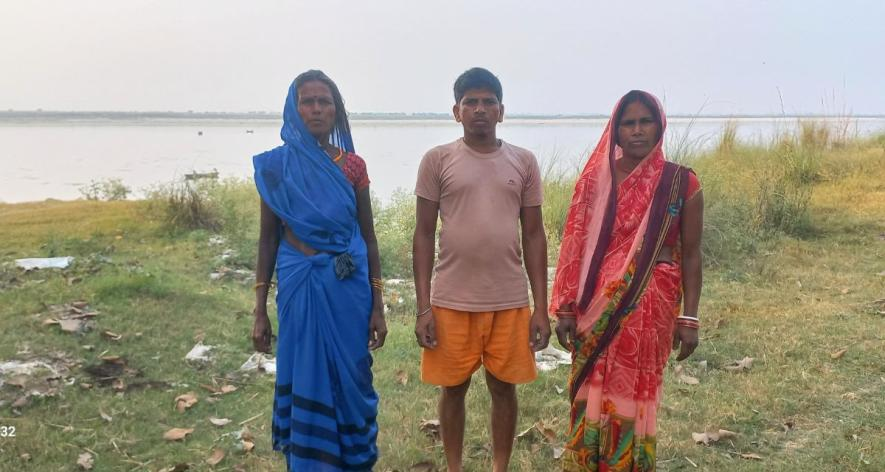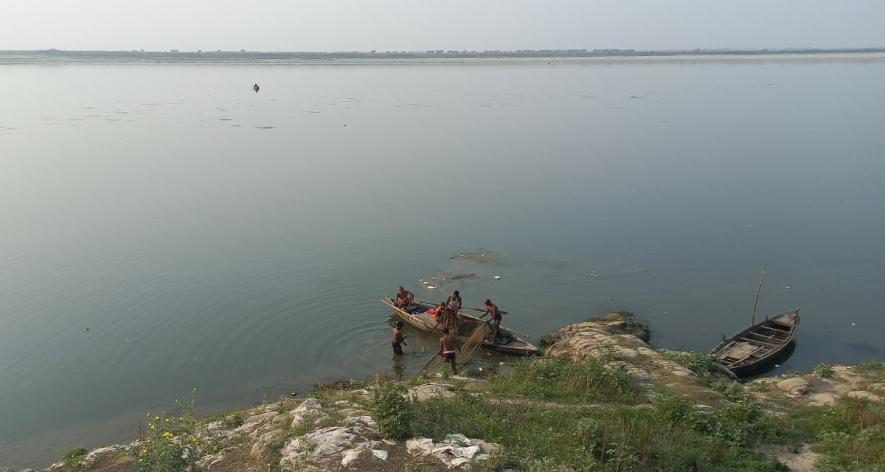Patna, Bihar: “Thirty years ago our land slipped into the lap of the Ganga River,” said Chandravati Devi (44) of Sohra Tribhuani village of Barhara block in Bihar’s Bhojpur district.
Her family once owned 50 bighas of land (over 31 acres; 1 bigha = 0.6 acre), but today, those fields lie across the river.
In the past 60 years, the Ganga’s constant erosion and shifting course have forced her to move several times. Once a landowner, she now survives as a daily wage labourer, living in a roadside hut at the edge of the village with her husband and four children.
Devi’s story echoes across Bhojpur, where thousands of farmers have been repeatedly displaced by the river’s unpredictable flow. “One by one, our lands are being swallowed by the Ganga while many areas teeter on the brink,” she said.
For families across the affected villages, losing their land has meant a life of instability. They are forced into makeshift huts along the Buxar–Koilwar embankment while they survive day to day with little to no help from the state, says Sohan Gond, a farmer.
The River Redraws Lives
To understand the story of Bhojpur, one has to look at the geography of the region. Bhojpur shares a border with Uttar Pradesh, and the altered course of the Ganga along the two states has deepened long-standing tensions between farmers on both sides.
According to Dayashankar Singh, a resident of Sohra Tribhuani who has spent years petitioning both the courts and governments of Bihar and UP, much of the land once owned by Bhojpur farmers now not only lies across the river but also across the state line.
This situation has sparked confusion and disputes over who legally owns the land, Singh says. “When a farmer from Bihar steps onto his old land, strongmen from UP threaten and drive him away,” he added.
In 1970, the Ganga dramatically altered its course, shifting from Ballia in UP towards the Bhojpur border in Bihar, causing widespread erosion. Over the past 46 years, the river has moved nearly 10 kilometres south into Bhojpur, turning thousands of acres of once-fertile farmland into barren stretches of sand and silt.
“And the remaining fertile land is now embroiled in a border dispute between Ballia and Bhojpur,” added Singh.
A Conflict Older Than Independence
Historical records show that the shifting Ganga has changed the geography of at least 192 villages across Bihar and Uttar Pradesh. Singh explained that the border dispute began under British rule and remains unresolved to this day.
From the colonial era through the late 20th century, contested ownership in the Diara region has often turned violent, with communities clashing over land rights. The Diara refers to tracts of land formed in the middle of the Ganga over decades due to the gradual deposition of sand.
In Sohra Tribhuani alone, nearly 5,600 bighas (3,500 acres) of land from the village and its surrounding areas were gradually submerged by the river and now lie across in UP. Despite repeated efforts to resolve the issue, including a demarcation attempt by the Trivedi Commission appointed by the government in 1960, no lasting solution has been achieved, said Singh.
Legal Red-Tape
Singh, who is also fighting for the restoration of his old land rights, explained that after the formation of the Trivedi Commission a significant portion of land in two maujas (a traditional revenue or administrative unit used in rural India) of the Barhara region—Mandrauli Kans (also known as Tribhuani) and Mohanpur—was transferred from Bihar to Uttar Pradesh, among other recommendations. These recommendations were accepted by the late Prime Minister Lal Bahadur Shastri and conveyed to the two state governments.
Later, the farmers of Bihar tried to apply for ryoti rights—legal tenancy rights that allow a person (called a rayat) to cultivate government-allocated land and claim ownership over it.
Although these rights are applicable across India, the farmers now had to approach Uttar Pradesh authorities since their land had shifted across the border.
However, they were denied the land rights
Singh said, “When we didn’t get ryoti rights from the Uttar Pradesh government, we were forced to approach the court. So, we filed a petition in the Allahabad High Court.” (Petition number 11720/86)
In 1997, the Allahabad High Court ruled in favour of the farmers, directing the Revenue Secretaries of both Bihar and Uttar Pradesh, along with the Surveyor General of India and district magistrates of Ballia and Bhojpur, to ensure that ryoti rights were granted to farmers of Mandrauli Kans and Mohanpur maujas within six months.

When no action was taken, the farmers filed a contempt petition (72610/98) against the officials. Following this, the Revenue Department of Uttar Pradesh issued a notification on March 25, 2000, officially including the two maujas in Uttar Pradesh.
Then, in 2007, the Ballia District Magistrate’s office published a notice in newspapers asking for verification of land records. “Farmers from Bihar promptly submitted their documents, but no action was taken. Later, in 2014, Rameshwar Singh from Sohra village filed a fresh petition in the Allahabad High Court, which resulted in a verdict in 2017—still, the Ballia administration remained inactive,” Singh said.
Frustrated by the ongoing delays, another Pawan Kumar Singh (60) filed another petition (10111/2017) in the same court. On October 4, 2017, the Ballia District Magistrate was ordered to collect documents from Uttar Pradesh farmers, but they failed to submit any. Seizing the opportunity, the Bihar farmers again submitted their land records, which the Ballia DM forwarded to the Bhojpur DM for verification.
However, the Bhojpur DM claimed that all land documents had been transferred to Ballia back in 1972, and no verification was possible. Since then, the Bihar farmers have been stuck between two district offices, still denied their raiyat (tenancy) rights.
“This is exactly why tensions keep flaring between farmers of Sohra and Padminiyabecause of errors made long ago by the survey officials…this is why we are still waiting for justice,” said Singh.
Landless Landowners
Due to ongoing conflicts, rightful landowners from Bihar are unable to farm their land, which remains under illegal occupation by strongmen from Uttar Pradesh, covering around 6,041 bighas.
Sohan Gond, a daily wage labourer from Sohra, said, “I’m landless today.” Forced to migrate for work, he struggles to find employment as he’s asked for caste and residence certificates—documents that the Bhojpur administration won’t issue since he has no legal claim to land. “My family of my wife, four children and I often survive without proper food, relying solely on daily wages of 300 to 350 rupees,” Gond says.
According to Singh, the situation remains unchanged due to the indifference of the Bihar and Uttar Pradesh governments. “This despite the fact that there are court orders over the issue. Farmers are still unable to reclaim their land. And across the Ganga, the strongmen from Uttar Pradesh have been farming on their land for years,” Singh added.
Singh explains that, according to the Trivedi Commission, the boundary between Bihar and Uttar Pradesh was established in 1882 based on the course of the Ganga and Saryu rivers, with the stream between them serving as the official border.
“Under that understanding, the farmers’ ryoti rights were meant to be protected and should remain intact,” he said.
Fight Forward
Singh saif that for years, farmers have pooled donations to fight for their land rights in court, but no one has received justice so far. The government’s efforts so far have also been insufficient, he adds.
The social worker is now trying to take the issue to the Prime Minister through the Bharatiya Kisan Sangh. He said, “The government must choose one of two options: either pass a proposal in the Lok Sabha to transfer the disputed land to Bihar, or grant the farmers ryoti rights based on their submitted documents.”
On this matter, the current District Magistrate of Bhojpur district, Tanai Sultania, expressed ignorance and said that further action would be taken after receiving the necessary information.
Himanshu Praveen is a freelance journalist and a member of 101Reporters, a pan-India network of grassroots reporters.
Courtesy: Newsclick

